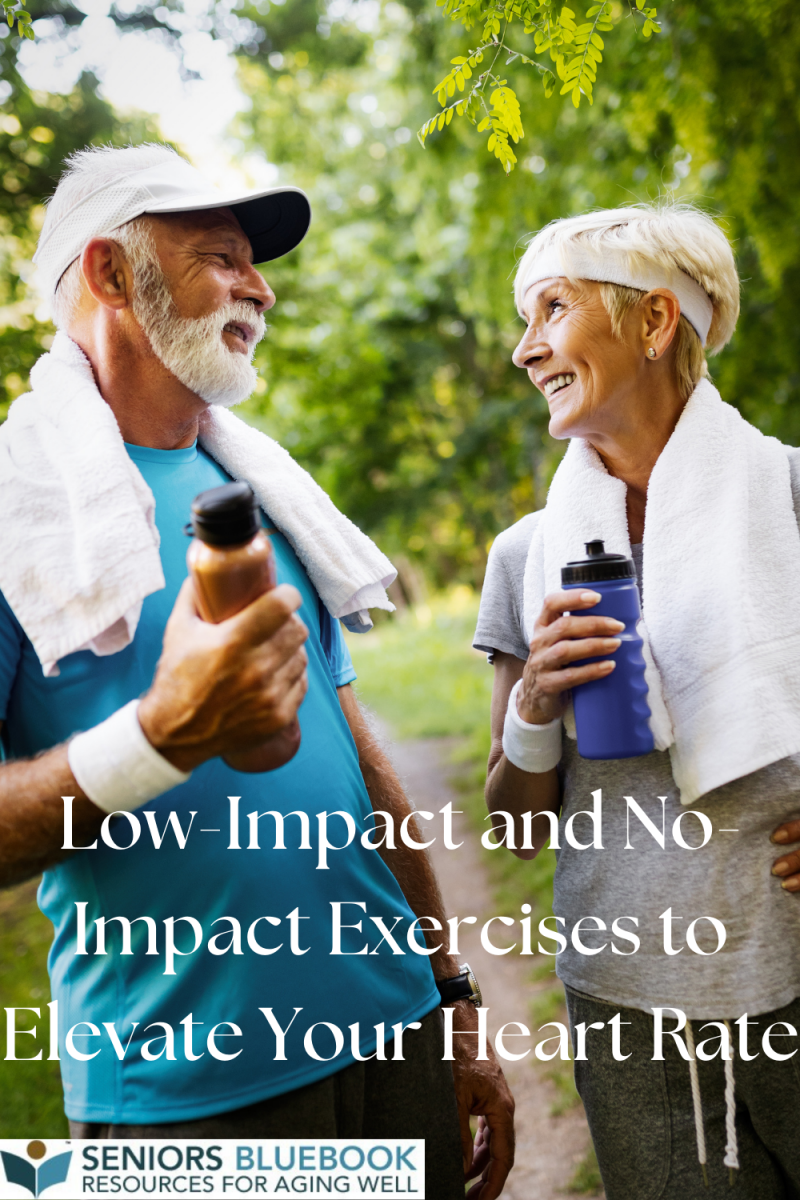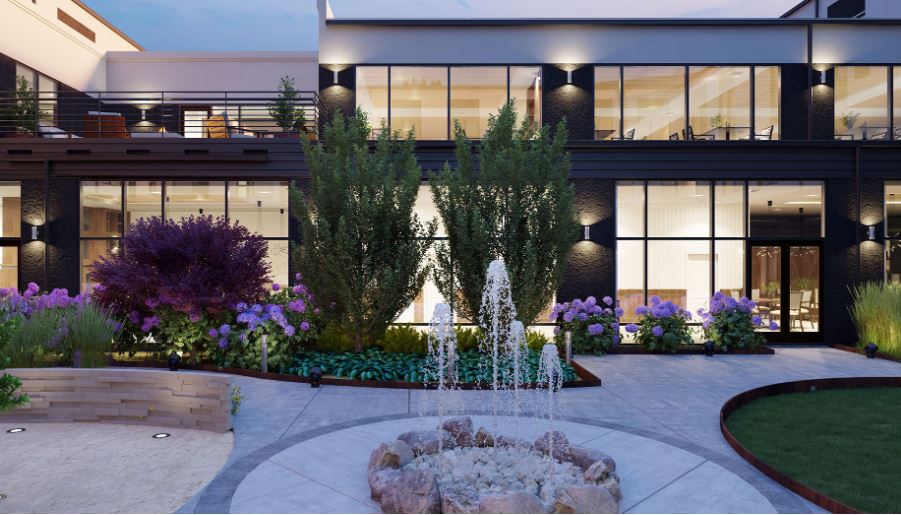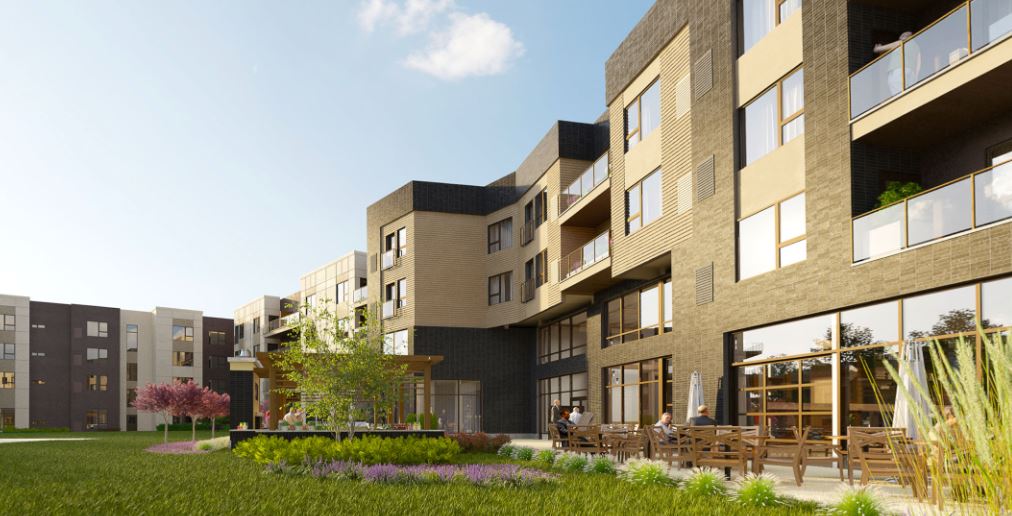Low-Impact and No-Impact Exercises to Elevate Your Heart Rate
Ovation Heartwood Preserve
Jan 20, 2022
Nebraska - Eastern Region
Email US
Click to Email UsDont let the term low-impact fool you these exercises are a great way to get in a good workout and increase your heart rate. From a technical perspective, a low-impact exercise is one in which one foot is always planted on the ground. No-impact exercises are those where both feet stay on the ground at all times or your body is supported by a machine or water during the workout.
Low-Impact Exercises
Low impact exercise for seniors has the same goal as any cardio workout get the heart beating. The difference with low-impact is you want something gentleon the joints. With high-impact exercises, the joints absorb most of the impact. For example, when you run, the back, hips, knees, and even feet absorb the energy as your body hits the ground. Low-impact takes a gentler approach.
Walking:
Walking for exercise has it all. It doesnt require fancy equipment or a trainer. It offers almost the same advantages as running but without the jarring joint problems. If you pick up the pace a bit, youll find your heart rate increases, too.
Hiking:
Hiking is walking with a little more purpose. Hikers walk on natural paths like the local nature trail. The exercise benefit of hiking is typically more than walking around your neighborhood, too. Natural surfaces are full ofinclines and uneven areas that add to the challenge.
Lunges:
A standard lunge puts one leg forward, with the knee bent and the other behind with the knee bent. It allows you to build strength and stability in some of your biggest muscles, including your back, stomach, buttocks, and thigh. Working these big muscles gets your heart pumping, as well.
Most Types of Dancing:
Dancing offers an overall, low-impact exercise that works almost every muscle, including the heart. It builds stability in the core and improves balance and coordination.
Rollerblading or Skating:
Skating is a comprehensive workout that activates all the muscles. It also builds leg strength but without taxing the joints.
Cross-Country Skiing:
Cross-country skiing increases your heart rate and your bodys ability to move oxygen. It involves most major muscles, too, so it builds strength and balance.
Step Aerobics:
Step aerobics provides a high-intensity workout but one that doesnt tax the joints. It builds muscle, reduces fat, and improves heart health.|
If youre at risk for injury, its much better to stick to low-impact exercises for seniors. Low-impact workouts are also ideal for people who have undergone hip or knee replacement surgery. Low-impact exercises are often prescribed as part of rehabilitation and recovery.
No-Impact Exercises
Low-impact is gentler than high-impact, but there is still some stress on the joints. What is no-impact exercise? No-impact exercise is any exercise that doesnt impact the joints. It is still possible to get a good workout with a no-impact exercise routine.
Swimming Laps:
Swimming is no-impact because the water absorbs most of the energy that affects the joints. Swimming is also a great way to build endurance, muscle, and cardio fitness.
Water Aerobics:
Like swimming, water aerobics allows you to move in a way that doesnt stress the joints. Water aerobics improves cardiovascular health and balance. It is also an effective choice for those with chronic pain.
Elliptical Machines:
An elliptical machine mimics the movements of walking or running but without the jarring effect of your weight coming down on your joints. It also allows for weight-bearing movement to fight off osteoporosis.
Stationary Bikes:
A stationary bike offers fluid movement and improves blood flow. Since you are working mostly withyour legs, it builds strength in some major muscle groups.
Rowing:
A rowing machine is a total body workout that uses almost all upper and lower body muscles. It is also relaxing and meditative.
Problem with High-Impact Exercises
When both feet leave the ground, such as when running or jumping rope, the body absorbs a lot of impact force. These impacts can be hard on bones, joints, tendons, ligaments, and muscles. High-impact exercises tend to burn more calories because theyre more intense workouts, but the chance for injury is much higher than with low-impact exercises. If youre at risk for injury, its much better to stick to low-impact exercises. Being able to do low-impact workouts is preferable to not being able to work out at all after suffering a preventable injury while pushing yourself too hard. Low-impact workouts are also ideal for people who have undergone hip or knee replacement surgery. Low-impact exercises are often prescribed as part of rehabilitation and recovery. Older people who want to avoid injuries that may take a long time to heal should stick almost exclusively to low-impact and no-impact exercises. Weakening bones and osteoporosis are common in older Americans, and theres not much you can do about it even if you adhere to a balanced diet and eat healthful foods. Refraining from high-impact exercises is one of the best ways to ensure you dont suffer an injury that will put you out of the game for a prolonged period of time. High-intensity workouts arent just a danger to your bones, joints, and ligaments. Regardless of age, theres an increased risk for heart attack and stroke if you push yourself too hard. This is doubly true for people who arent acclimated to high-intensity training. If you want to start working out to lose weight you should be commended for your efforts, but you shouldnt immediately join a CrossFit gym and hit their routines with maximum intensity. Its important to gradually increase your workout intensity as your body strengthens. Starting out gradually with low-impact and no-impact exercises is almost always the best way to start your journey. If you have one of these three conditions, stick to low-Impact or no-Impact exercises.
Diabetic Neuropathy
Diabetics who experience diabetic neuropathy will likely struggle with high-impact exercises due to the pain and numbness they often experience in their legs and feet.
Arthritis
Depending on the severity of your arthritis and where you have joint damage, high-impact exercises may not be possible. People with arthritis in the hips, knees or feet should still find ways to exercise, but its important to participate in safe low- and no-impact options.
Osteoporosis
People with compromised bone density should abstain from high-impact exercises that could cause stress fractures.
Other Articles You May Like
Sun Safety for Everyone with These Sun Safety Tips
Stay Sun-Safe with These Sun Safety Tips Summer is in full swing and with it comes the long-awaited sunshine. While the sun can provide many benefits, it can also be detrimental to our health if we do not take care to protect ourselves. Whether you're spending time outdoors on a sunny day, going for a walk or just sitting on the porch, protecting yourself from harmful rays should always be a top priority. In this blog post, we will share tips and tricks on how to keep safe in the sun. Facts and Stats About Skin Cancer Staying ahead of skin cancer means staying informed about its causes, risks, and outcomes. The Skin Cancer Foundation (Opens in a new window) shares the following staggering facts and stats about skin cancer in the United States: 1 in 5 Americans will develop skin cancer by the age of 70. Every hour, more than 2 people die of skin cancer in the U.S. Your risk for melanoma doubles after experiencing five or more sunburns. Early detection of melanoma leads to a 99% 5-year survival rate. Risks of Skin Cancer and Who is Most at Risk Although anyone can develop skin cancer, some people are more at risk than others. According to the American Cancer Society (Opens in a new window), those with fair skin, light hair, and blue or green eyes are more likely to get skin cancer, as are those with a personal or family history of skin cancer. Additionally, exposure to UV rays from the sun or tanning beds can greatly increase your risk. And while skin cancer can happen at any age, it's more common in people over the age of 50, says the Skin Cancer Foundation (Opens in a new window). Tips for Staying Safe in the Sun We all want to make sure that were taking the best possible care of ourselves and our loved ones, especially when it comes to protecting ourselves from the dangers of spending too much time in the sun. Overexposure can lead to serious health risks such as dehydration, sunburns, heat exhaustion even skin cancer so its imperative for us to be aware of sun protection methods during outdoor activities. Here are some sun safety tips to bear in mind when spending time outside: Apply sunscreen regularly: Use a broad-spectrum sunscreen (SPF of 30 or higher) that blocks both UVA and UVB rays. To ensure that sunscreen is evenly applied, use about an oz (a shot glass) worth of sunscreen or enough to fit in the palm of your hand. Reapply every two hours or immediately after swimming or sweating. Wear appropriate clothing: Wear loose, comfortable clothing that covers as much skin as possible, such as long-sleeved shirts and pants. Consider sun protective clothing with UV blocking fabric. Seek shade: Stay under the shade as much as possible and always use an umbrella, tent, or other porous objects to provide shade. Again, avoid being in the midday sun from 10 a.m. to 4 p.m., when UV rays are the strongest. Wear a hat: Wearing a wide-brimmed hat is a great way to protect your face, ears, and neck from the sun. Hydrate: Drink plenty of water being in the sun can be dehydrating. Dont be fooled by cloudy weather: UV radiation can still damage your skin, even on a cloudy day. It is important always to apply sunscreen when going outside for an extended period. Tips for Preventing Skin Cancer According to the Centers for Disease Control and Prevention (Opens in a new window), skin cancer is the most common type of cancer in the U.S., and it affects millions of people every year. It is caused by damage to the skin cells caused by the sun's harmful UV rays. CDC research show that certain people carry risk factors that make them more susceptible to skin cancer (Opens in a new window). Whether you have risk factors for cancer or not, there are plenty of ways to protect your skin from the sun and prevent skin cancer: Monitor your medications: Some medications can make your skin more sensitive to the sun. If you are taking any prescription drugs, talk to your doctor, or pharmacist, about the potential side effects and how to protect your skin. Live a healthy lifestyle: Eating a healthy diet, getting regular exercise, and managing stress can all have a positive effect on your skin. By living a healthy lifestyle, you can give your skin the best chance of staying healthy and avoiding skin cancer. Avoid Tanning Beds: If you're looking to get a tan, skip the tanning bed and opt for a self-tanner instead. Tanning beds expose your skin to harmful UV rays, increasing your risk of skin cancer. Get Regular Skin Checks: Schedule regular appointments with a dermatologist to have your skin checked for any signs of skin cancer. Catching it early can greatly improve your chances of successful treatment. Protect. Protect. Protect: As mentioned above, some of the most proactive steps you can take to protect yourself from skin cancer is to seek the shade; avoid the suns UV rays when they are strongest between 10 am and 4 pm; wear sun protective clothing; and use a broad-spectrum sunscreen with an SPF of 30 or higher. Call today for more information 303-300-6666.
Why Seniors Should Try Quinoa
March is National Quinoa Month and now is the perfect time learn about this tasty superfood and how it can help you and your senior parent stay healthy. Quinoa is a grain, but most people arent as familiar with it as they are with grains like oats or wheat. Quinoa is considered a superfood because its packed with vitamins and essential nutrients. And its a very versatile grain that can be used in lots of different dishes.Estimates are that more than 70% of seniors are malnourished, even seniors who eat regularly. Not eating, or not eating healthy foods, can contribute to poor health in seniors and can make existing medical conditions worse. Thats why seniors should learn about the many health benefits of quinoa.In-home care can help seniors prepare healthy and tasty meals to help battle malnutrition. With the help of in-home care providers seniors can prepare and try lots of new healthy foods, including quinoa. Some of the reasons why seniors should try quinoa today are:Essential Vitamins and MineralsQuinoa is a nutrient-dense food, packed with essential vitamins and minerals. It is an excellent source of protein, containing all nine essential amino acids, making it a complete protein. Seniors who arent getting enough protein can add protein to salads or soups by adding quinoa to those dishes.Full Of FiberQuinoa is a good source of dietary fiber, both soluble and insoluble. Fiber plays a crucial role in digestive health by promoting regular bowel movements, preventing constipation, and supporting a healthy gut microbiome. Eating more fiber can also lower the risk of chronic diseases like heart disease and diabetes.Its Gluten FreeQuinoa is naturally gluten-free, making it a suitable grain alternative for those with gluten sensitivity or celiac disease. It provides a safe and nutritious option for individuals who need to avoid gluten-containing grains.AntioxidantsQuinoa is rich in antioxidants, including quercetin and kaempferol. These compounds help neutralize harmful free radicals in the body, protecting cells from oxidative stress. Antioxidants play a role in reducing inflammation and may contribute to overall health and disease prevention.Heart HealthyQuinoa is beneficial for heart health due to its high fiber content, which helps lower cholesterol levels. Additionally, it contains heart-healthy monounsaturated and polyunsaturated fats. The combination of fiber and healthy fats supports cardiovascular function and may reduce the risk of heart disease.Blood Sugar RegulationThe complex carbohydrates and fiber in quinoa contribute to stable blood sugar levels. This is particularly beneficial for seniors with diabetes or those at risk of developing diabetes. Eating quinoa instead of pasta or rice is recommended for seniors with diabetes. Quinoas low glycemic index helps prevent rapid spikes and crashes in blood sugar.Weight ManagementThe combination of protein, fiber, and complex carbohydrates in quinoa can contribute to a feeling of fullness and satiety. Including quinoa in meals may help control appetite, which can help seniors who are struggling to maintain a healthy weight.Better Bone HealthQuinoa is a good source of important minerals for bone health, including magnesium, phosphorus, and manganese. These minerals play a crucial role in maintaining strong and healthy bones, preventing conditions like osteoporosis.Rich in Essential MineralsQuinoa is a notable source of essential minerals, including iron, magnesium, phosphorus, and zinc. These minerals are vital for various bodily functions, such as oxygen transport, energy production, and immune system function.VersatilityQuinoas versatility makes it an easy and enjoyable addition to various dishes. It can be used in salads, soups, casseroles, and as a side dish. Its neutral flavor allows it to complement a wide range of ingredients, making it a flexible and nutritious ingredient in the kitchen.Improved Digestive HealthThe fiber in quinoa supports digestive health by promoting regular bowel movements and providing prebiotics for the growth of beneficial gut bacteria. A healthy digestive system is essential for nutrient absorption and overall well-being. If you or an aging loved one are considering In-Home Care in Boulder, CO please contact the caring staff at Talem Home Care & Placement Services today. Call (720) 789-8529At Talem Home Care of Broomfield, we provide passionate, understanding, and flexible caregivers in Broomfield, Arvada, Aurora, Boulder, Brighton, Commerce City, Denver, Erie, Firestone, Lafayette, Lakewood, Longmont, Louisville, Northglenn, Sherrelwood, Thornton, Welby, Westminster, Wheat Ridge and surrounding areas in Colorado.
What Is a Clinical Pharmacist and What Do They Do?
Do you or your loved one take prescribed medications for a chronic condition? Managing pills might become overwhelming. Not only that, but it is also important to ensure that the medications work efficiently to enhance your or your loved ones well-being. This is when the services of a clinical pharmacist become invaluable. A clinical pharmacist specializes in direct patient care, collaborating with healthcare teams to optimize medication therapy. Read on to learn more about how clinical pharmacists can help you.Assessment and EvaluationClinical pharmacists analyze the status of a patient's health conditions and scrutinize the prescribed medications. They identify potential gaps or discrepancies in the treatment, ensuring that medications align with the patient's needs and therapy goals.Uncovering Untreated Health IssuesBeyond merely dispensing medications, clinical pharmacists uncover untreated health problems that could benefit from appropriate medication therapy. Through their thorough evaluations, they identify areas where intervention can lead to improved patient well-being and quality of life.Monitoring and ConsultationThe journey doesn't end with a prescription. Clinical pharmacists walk alongside patients, monitoring their progress and evaluating the effects of medications on their health. This ongoing assessment allows for timely adjustments and interventions, ensuring that the treatment remains on track. Moreover, clinical pharmacists collaborate with physicians and other healthcare providers, offering valuable insights and recommendations to optimize medication therapy and contribute to overall care goals.Patient Education and SupportEmpowering patients with knowledge is a cornerstone of the clinical pharmacist's role. They offer guidance on medication administration, helping patients navigate dosages and get a thorough understanding of potential side effects. Clinical pharmacists extend their support beyond pills and prescriptions, advocating for holistic approaches to health by promoting practices like exercise, proper diet, and preventive measures such as immunizations.Integrated Patient CareClinical pharmacists collaborate with healthcare teams to develop and implement comprehensive medication plans tailored to individual patient needs.Personalized Care and Professional RelationshipsClinical pharmacists forge meaningful connections with patients, taking the time to understand their unique concerns, preferences, and aspirations. This human touch infuses their practice with empathy and understanding, fostering trust and collaboration on the journey towards better health.How We Can HelpAt Deeper Dive Horizons, our clinical pharmacists can help you or your loved one through one of the following services:S.H.I.P ProgramThrough six one-on-one sessions conducted via phone or zoom, the S.H.I.P. program focuses on four key pillars: safe and effective medication therapy, promotion of healthy lifestyles, overcoming healthcare and lifestyle barriers to independent living, and provision of resources for senior and caregiver well-being. Deep Dive Medication ReviewThis program provides a deep dive into medication management for seniors who are on multiple medications and may feel that their current therapy is suboptimal for their chronic conditions. Over two sessions, the program offers tailored medication review plans in collaboration with the patient's primary care physician. Follow-up sessions assess the success of interventions and determine if further comprehensive programs are needed to achieve goal-directed health outcomes.Sailing Home ProgramThe Sailing Home Program focuses on ensuring a smooth transition for seniors from hospital to home, reducing the risk of re-hospitalization by reconciling medications, and addressing medication-related issues. This includes evaluating duplicate therapy, drug-drug interactions, drug-disease interactions, appropriate dosing based on patient-specific data, and assessing the complexity of drug regimens in relation to the senior's independence and support systems. If you or your loved one are looking for a clinical pharmacist, contact us at Deeper Dive Horizons to schedule a consultation 888-984-8895.
Local Services By This Author
Ovation Heartwood Preserve
Independent Living 471 Maxwell Plaza, Omaha, Nebraska, 68154A lifetime of hard work and service is worth a standing ovation and the chance to engage at your own pace. Ovation Heartwood Preserve in Omaha, Nebraska is a vibrant, secure, and active adult lifestyle village where independent living, assisted living, and memory care are inspired by life and Omahas interwoven history and scenery.
Ovation Heartwood Preserve
Assisted Living 470 Maxwell Plaza, Omaha, Nebraska, 68154A lifetime of hard work and service is worth a standing ovation and the chance to engage at your own pace. Ovation Heartwood Preserve in Omaha, Nebraska is a vibrant, secure, and active adult lifestyle village where independent living, assisted living, and memory care are inspired by life and Omaha's interwoven history and scenery.
Ovation Heartwood Preserve
Memory Care 470 Maxwell Plaza, Omaha, Nebraska, 68154A lifetime of hard work and service is worth a standing ovation and the chance to engage at your own pace. Ovation Heartwood Preserve in Omaha, Nebraska is a vibrant, secure, and active adult lifestyle village where independent living, assisted living, and memory care are inspired by life and Omahas interwoven history and scenery.



